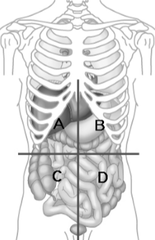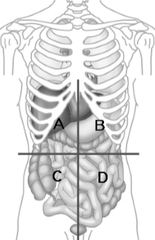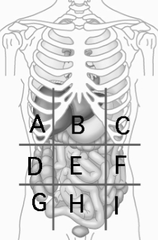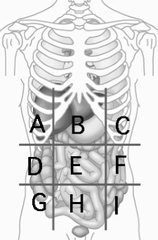Biology 141: Anatomy and Physiology – Flashcards
Unlock all answers in this set
Unlock answersquestion
What are the 7 subtopic of Anatomy?
answer
cytology, developmental, embryology, gross, histology, pathology, radiology
question
Science of the body relevant to the shape/form (the make-up
answer
Anatomy
question
"Study of cell population" and the patterns of, if there's abnormalities
answer
Cytology
question
"Study of tissues" structural piece made from aggregation or accumulation of similar cells
answer
histology
question
name the four types of tissues
answer
nervous, muscle, connective, epithelial
question
"study of developmental process in the uterus"
answer
embryology/fetology
question
"study of disease/injuries in a structure and how they impact that structure
answer
pathology
question
using the advancement of technology to see different angles/presentation at deep levels without cutting open
answer
radiology
question
-birth to death (lifespan) -covers entire existence to see how it changes and presents itself
answer
developmental
question
"large" appreciation of body through naked eye
answer
gross
question
name two types of gross
answer
systematic and regional
question
curious to explore all parts of body
answer
systematic gross
question
look only at a particular spot of body
answer
regional gross
question
study of action/process/function of body and has 11 body systems
answer
physiology
question
What are the 14 things that prove there's life?
answer
cellular presence, metabolism, DNA presence, homeostasis, water, growth, stimuli, adjust adapt evolve, excretion, digestion, circulation, respiratory response, reproduction, cellular respiration
question
Name 2 types of cellular presence
answer
unicellular and multicellular
question
-sum total of all the chemical processes in the body geared toward satisfying nutritional/energy needs
answer
metabolism
question
"build up." small atoms and chemically connect them together for a bigger structure
answer
anabolism
question
large chemical broken into subunits
answer
catabolism
question
What does DNA stand for?
answer
deoxyribonucleic acid
question
internal environment is stable and helps deal with external world
answer
homeostasis
question
enlarge the structure without destroying its basic outline
answer
growth
question
"growing up"
answer
hyperplasia
question
"growing out"
answer
hypertrophy
question
variable that evokes a response physically, behaviorally, etc.
answer
stimuli
question
get rid of waste material
answer
excretion
question
break down food
answer
digestion
question
internal mechanism for moving nutrients through body and pickup to remove waste
answer
circulation
question
able to exchange gases (breathing)
answer
respiratory response
question
able to use a gas to burn calorie molecules for energy (ATP)
answer
cellular respiration
question
What is the Hierarchical Structural Order for and organism? (Least to Complex)
answer
atoms, molecules, organelles, cells, tissues, organs, organ systems, organism
question
What are the 8 characteristics of human beings?
answer
Large cranial capacity, heaviest brain, ladies have flared pelvis structures, bipedalism, manual dexterity, varies teeth structure, weakest pounds per pressure bites, and prominent chins
question
monitor/survey homeostatic variables tied to
answer
homeostatic feedback systems
question
What are the 4 steps?
answer
set point, receptors, control center, and effectors
question
where the variable is
answer
set point
question
gather information about a variable
answer
receptor
question
brain/spinal chord
answer
control center
question
makes sense of
answer
interpretation
question
response
answer
integration
question
muslces, glands/hormones of body sends what to do
answer
effectors
question
nothings wrong
answer
inhibitory response
question
fix what's wrong
answer
excitatory response
question
part of brain that deals with basic biology of body
answer
hypothalamus
question
"sweat glands"
answer
sudoriferous glands
question
"smooth muscles"
answer
arrector pili muscles
question
-releases something in the body to raise/lower it in the body -most common in body
answer
negative feedback
question
example of positive feedback in the body?
answer
pregnancy
question
lining of wall of chest wall, pelvic, and abdominal walls; slippery, moist, releases clear fluids
answer
serous
question
What quadrant is A?
answer
upper right quadrant
question
What quadrant is B?

answer
left upper quadrant
question
What quadrant is C?
answer
lower right quadrant
question
What quadrant is D?

answer
lower left quadrant
question
fleshy part of ear
answer
pinna
question
hole in ear (external auditory means)
answer
meatus
question
What is region A?
answer
hypochondriac
question
What is region B?
answer
epigastric
question
What is region C?
answer
left hypochondriac
question
What is region D?

answer
right lumbar
question
What is region E?

answer
umbilicus
question
What is region F?

answer
left lumbar
question
What is region G?
answer
right iliac/inguinal
question
What is region H?
answer
hypo gastric
question
What is region I?
answer
left iliac/inguinal
question
"skin"; out covering of people
answer
cutaneous membrane
question
makes sticky fat ("lipid") sugar. Traps stuff so that it can be expelled out body and opening/orifices are lined with this
answer
mucous membrane
question
lining of cavities
answer
serous membrane
question
inability to hold body together and make ATP
answer
death
question
science of substances (presence of them, the relationships)
answer
chemistry
question
anything that takes up space and has a mass
answer
matter
question
humans are made of 95% of these four atoms
answer
carbon, oxygen, hydrogen, nitrogen (COHN)
question
All living things are 95% of these five atoms
answer
sulfur, phosphorous, oxygen, nitrogen, carbon, hydrogen (PONCH)
question
we need little bits but could have major issues without them
answer
trace elements
question
capacity to do work (source=sun)
answer
energy
question
made of subatomic particles unseen by human eyes
answer
atoms/elements
question
What is the charge, position and weight of an electron?
answer
negative charge, orbitals and weightless
question
What is the charge, position and weight of a proton?
answer
positive charge, nucleus and 1 A.M.U
question
What is the charge, position and weight of a proton?
answer
neutral charge, nucleus and 1 A.M.U
question
naturally occurring forms of an atom/element in nature which differ in terms of their neutrons and atomic weight
answer
isotopes
question
the higher the value, the stronger the ability to attract other atoms to you
answer
electronegativity
question
number of electrons in outer most shell
answer
valence
question
atoms long to have full shells
answer
octet rule
question
bond between a metal and nonmetal
answer
ionic
question
is an atom that has either released or received an extra electron
answer
ion
question
ions with a positive charge
answer
cation
question
ions with a negative charge
answer
anion
question
2 atoms share a pair of non-mental electrons
answer
covalent
question
"unequal" sharing of electrons
answer
polar covalent bond
question
other things dissolve in well (does the dissolving)
answer
solvent
question
things you want dissolved
answer
solute
question
weaker bonds
answer
hydrogen and vander waals forces
question
week electrostatic current bonds. Attraction between electrons that overlap because they're big molecules
answer
vander waals forces
question
gas (pooting)
answer
flatulence
question
A + B =C
answer
synthesis
question
C = A+B
answer
decomposition
question
AB + CD = AC + BD
answer
exchange reaction
question
specialized exchange reaction between acids and bases
answer
neutralization
question
release hydrogen ions (H+) in water
answer
acids
question
release hydroxide (OH-) in water
answer
bases
question
take 2 destructive things, bring them together, and get something less harmful/destructive (get water and salt from it usually)
answer
neutralization reaction
question
Factors that influence chemical reactions
answer
temperature, catalytic effects, particle size, PH status, and concentration
question
more outcome or faster atoms
answer
higher temperatures
question
less outcome or slower atoms
answer
lower temperatures
question
causes lower activity energy and speeds up chemical reactions
answer
enzymes
question
minimal amount of energy needed to push reaction forward
answer
activation energy
question
helper of enzyme
answer
coenzymes
question
usually metal, raise temperatures because the metal absorbs more heat
answer
cofactors
question
collide/crash more and move faster
answer
small particles
question
decrease collision/crash and moves slower
answer
large particles



